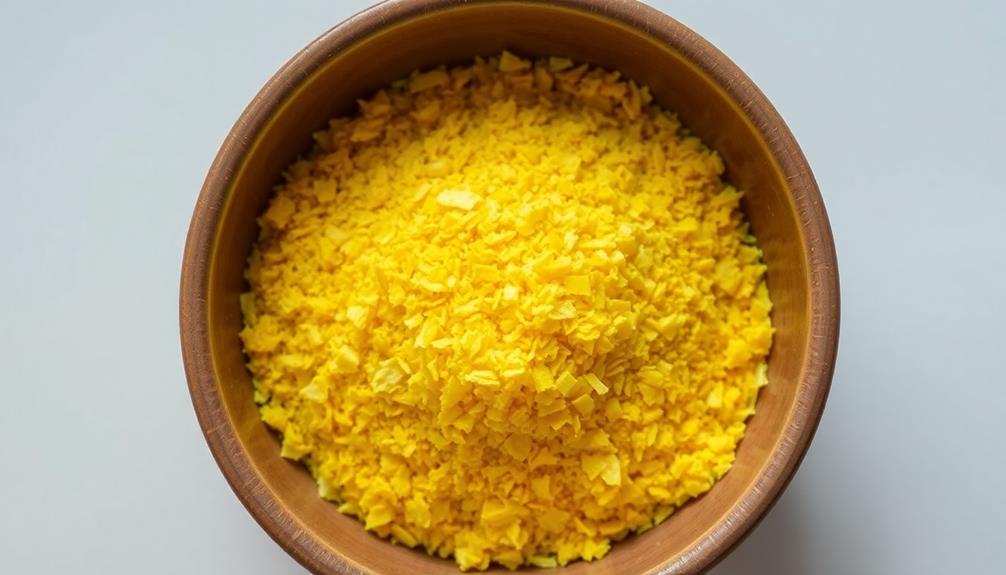Breadfruit is a resilient, climate-adapted food source that can withstand extreme weather and grow in various soils. It offers a rich nutritional profile, providing complex carbohydrates, vitamins, minerals, fiber, and antioxidants that support your health. Its low maintenance and pest resistance make it an ideal staple for vulnerable regions. If you’re curious about how this versatile fruit can help build resilient food systems, there’s more to discover below.
Key Takeaways
- Breadfruit provides complex carbohydrates, vitamins, and minerals, supporting nutritional needs in climate-affected regions.
- Its high dietary fiber promotes digestive health, essential during food shortages or dietary shifts.
- Rich in antioxidants, breadfruit helps combat oxidative stress caused by environmental changes.
- Contains moderate protein, making it a valuable supplement to traditional staples for balanced nutrition.
- Its resilience and year-round fruiting ensure a reliable, nutritious food source amid climate uncertainties.

As climate change threatens traditional food sources worldwide, breadfruit emerges as a promising resilient staple. Its ability to withstand extreme weather conditions makes it an excellent candidate for climate adaptation strategies. In regions where crops like rice, maize, and wheat struggle due to unpredictable rainfall, drought, or storms, breadfruit offers a reliable alternative. Its hardy nature means you can diversify your crop portfolio, reducing dependency on vulnerable staples and strengthening food security. By integrating breadfruit into your farming system, you’re not only adapting to changing climates but also building resilience against future shocks.
Breadfruit’s resilience offers a vital solution for adapting to climate change and securing food systems worldwide.
You’ll find that breadfruit’s nutritional profile makes it a versatile and valuable addition to your diet. It’s rich in complex carbohydrates, providing sustained energy, and supplies essential vitamins and minerals such as vitamin C, potassium, and dietary fiber. The high fiber content supports digestive health, while the antioxidants help combat oxidative stress, which can increase with climate-induced environmental changes. Its moderate protein content adds to its nutritional value, making it a well-rounded food source that can supplement or replace more traditional staples during times of scarcity.
In terms of crop diversification, breadfruit offers several advantages. It grows on large trees that can reach impressive heights, providing not only edible fruit but also shade and habitat for other crops or wildlife. Its ability to produce fruit multiple times a year ensures a consistent food supply, even in adverse conditions. Additionally, breadfruit trees require relatively low maintenance once established, making them suitable for smallholder farmers seeking sustainable options. Incorporating breadfruit into your agricultural practices helps spread risk; if one crop fails due to drought or pests, others can still thrive, ensuring your community’s food security.
Furthermore, breadfruit’s resilience to pests and diseases, compared to other tropical crops, reduces the need for chemical interventions, supporting environmentally friendly farming practices. Its capacity to grow in a variety of soil types, including poor or degraded soils, makes it accessible to farmers in less fertile regions. This adaptability aligns perfectly with climate adaptation efforts, enabling communities to continue producing nutritious food despite environmental challenges. Understanding the plant’s hardy nature helps farmers select the most suitable crops for shifting environmental conditions. By prioritizing crop diversification with breadfruit, you’re not just safeguarding your food supply—it’s a step toward sustainable agriculture that coexists with the changing climate.
Frequently Asked Questions
How Does Breadfruit Cultivation Impact Local Ecosystems?
You might wonder how breadfruit cultivation affects local ecosystems. When you grow breadfruit, it can improve soil health by adding organic matter and reducing erosion. However, if not managed carefully, it could impact biodiversity by replacing native plants and habitats. Responsible cultivation practices help balance these effects, supporting ecosystem resilience while benefiting from breadfruit’s climate resilience and nutritional benefits.
Can Breadfruit Be Cultivated in Non-Tropical Regions?
Imagine trying to plant a tropical seed in a cold climate, where frost whispers and soil demands differ. You might think breadfruit can adapt, but its roots need warm, moist soil and consistent warmth to thrive. Outside tropical zones, cold climate and soil requirements challenge its growth. Without the right conditions, breadfruit struggles, like a traveler lost in winter’s chill, unable to flourish beyond its native, sunny paradise.
What Are Traditional Breadfruit Recipes Worldwide?
You might wonder about traditional breadfruit recipes worldwide. Many cultures incorporate breadfruit into their cuisine, like Caribbean fried breadfruit, West African stews, and Polynesian roasts. These recipes highlight its versatility and nutritional benefits, offering a rich source of fiber and vitamins. Exploring traditional recipes lets you enjoy its delicious flavor and nutritional value while celebrating diverse culinary traditions, making breadfruit a valuable staple across different regions.
How Does Breadfruit Compare to Other Climate-Resilient Crops?
You’ll find that breadfruit outshines many climate-resilient crops because it supports sustainable farming and promotes crop diversity. Unlike some crops, breadfruit thrives in diverse environments, resisting pests and climate stress. Its high yield per tree makes it an efficient staple, reducing land use pressure. You can see it as a versatile, resilient option that helps diversify your food sources and strengthens food security amid changing climate conditions.
Are There Any Known Allergies Associated With Breadfruit?
Ever wonder if breadfruit might cause food allergy concerns? While it’s generally safe, some people may experience allergic reactions, especially those with latex allergies, due to cross reactivity issues. Though rare, certain individuals could have sensitivities. Always consult a healthcare professional if you’re unsure. Knowing about potential allergies helps you enjoy this nutritious staple safely, like a treasure chest filled with health waiting to be opened.
Conclusion
By incorporating breadfruit into your diet, you help build climate resilience and improve nutrition. Imagine a small island community planting breadfruit trees to withstand hurricanes and droughts, ensuring food security for generations. This resilient crop not only nourishes but also supports sustainable farming practices. Embrace breadfruit as a climate-smart staple, and you contribute to a more secure, nourishing future for communities facing climate challenges.









